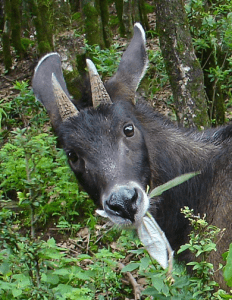TAG: GS 3: ECOLOGY AND ENVIRONMENT
THE CONTEXT: The mainland serow (Capricornis sumatraensis thar), a unique antelope-like mammal typically found in Bhutan, has been recorded at the lowest elevation ever observed in western Assam’s Raimona National Park.
EXPLANATION:
- This significant finding, along with photographic evidence, has been documented in the Journal of Threatened Taxa, marking a notable event for biodiversity conservation in the region.
Himalayan serow (Capricornis sumatraensis thar)
- The Himalayan serow (Capricornis sumatraensis thar), also known as the thar is a subspecies of the mainland serow native to the Himalayas.
- It was previously considered its own species, as Capricornis thar.
- Traditionally, the mainland serow is known to inhabit regions at altitudes between 200 and 3,000 meters above mean sea level.
- However, this recent observation recorded the animal at a mere 96 meters above mean sea level, far beyond its usual altitudinal range and closer to human habitation than previously documented.
- It is the official state animal of the Indian state of Mizoram.
- Capricornis sumatraensis is listed in CITES Appendix I.
- It has been categorized as Vulnerable as per the IUCN Red List.

Significance of the Discovery
- This discovery in Raimona National Park is noteworthy for several reasons:
- Conservation Implications:
- The presence of the mainland serow at such a low elevation and near human habitation indicates a potential expansion or shift in habitat range, which can be crucial for developing effective conservation strategies.
- Biodiversity Indicator:
- The serow’s presence signifies good ecological health in Raimona National Park, indicating that the conservation efforts and habitat restoration initiatives are yielding positive results.
- Habitat Restoration:
- Raimona National Park, previously affected by poaching and habitat degradation due to logging, is now showing signs of recovery.
- The sighting of the serow supports ongoing efforts to rehabilitate and conserve the region’s biodiversity.
- Conservation Implications:
Conservation Challenges
- Despite the positive implications of this discovery, the mainland serow faces several challenges:
- Habitat Loss: Fragmentation and destruction of natural habitats due to human activities remain significant threats.
- Poaching: The species is still vulnerable to poaching for bushmeat and other purposes.
- Data Deficiency: A lack of reliable data on the mainland serow’s population and distribution complicates the formulation of effective conservation measures.
Conservation Efforts and Future Actions
- The Assam government declared the 422 sq. km area of Raimona a national park on June 8, 2021, a move aimed at bolstering conservation efforts.
- The recent sighting of the mainland serow underscores the need for continued and enhanced conservation efforts.
- These efforts include:
- Species Population Recovery: Focused initiatives to increase the population of the mainland serow.
- Habitat Restoration: Ongoing projects to restore degraded habitats within the national park.
- Anti-Poaching Measures: Strengthening anti-poaching laws and enforcement to protect vulnerable species.
- Research and Data Collection: Comprehensive studies to gather reliable data on the mainland serow and other species to inform and improve conservation strategies.
Raimona National Park
- Raimona National Park is located in the Kokrajhar district of Assam, India.
- It was declared a national park on June 5, 2021, by the announcement of Assam’s Chief Minister on the occasion of World Environment Day at Gandhi Mandap, Guwahati.
- The park is spread across Gossaigaon and Kokrajhar subdivisions of Kokrajhar district of Bodoland Territorial Region.
- It is a part of a contiguous forest patch with an area of 422 square kilometers (163 square miles) covering the northern part of the notified Ripu Reserve Forest (508.62 square kilometers (196.38 square miles)), which forms the westernmost buffer to Manas Tiger Reserve in the foothills of Eastern Himalaya Biodiversity Hotspot 13.
- The park is home to a variety of wildlife including tiger, clouded leopard, golden langur, Indian gaur, Asian elephant, spotted deer, wild buffalo, and hornbill.

